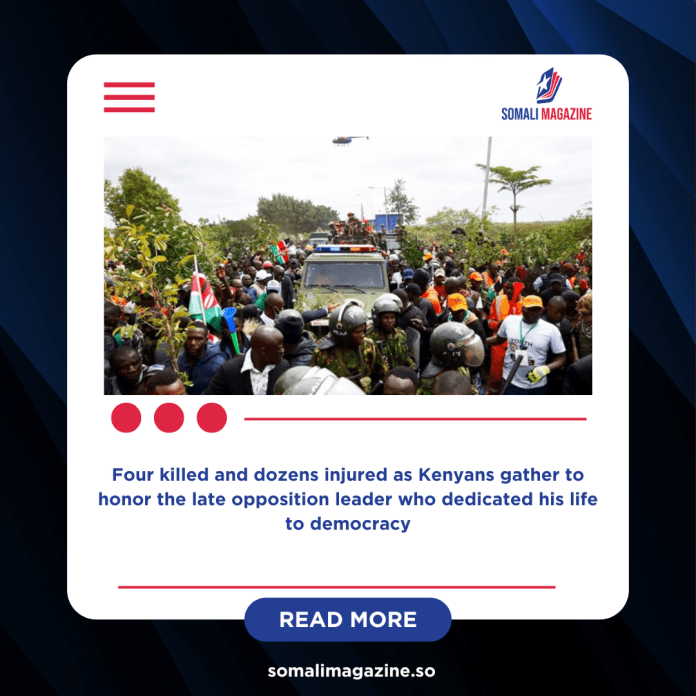Facebook Twitter (X) Instagram Somali Magazine - People's Magazine
Four people were killed in Nairobi on Thursday after security forces opened fire and used tear gas to disperse massive crowds gathered to view the body of opposition leader Raila Odinga, who died a day earlier in India at the age of 80. Odinga, a towering figure in Kenyan politics for decades, had been receiving medical treatment abroad before his passing.
Tension began early in the morning as thousands of mourners filled the streets of Kenya’s capital to pay their final respects. The situation turned chaotic when a large crowd forced its way through the gate of Nairobi’s main stadium, where Odinga’s body was lying in state. Witnesses said soldiers fired into the air to control the crowd, while police later used tear gas to scatter people. Local media, including KTN News and Citizen TV, reported that four people were killed and many others injured in the commotion.
The violence forced security forces to clear the stadium, leaving it deserted just hours after it had been filled with mourners waving flags, singing, and chanting Odinga’s name. Earlier in the day, thousands had stormed Nairobi’s international airport, where President William Ruto and other officials were holding a ceremony to receive Odinga’s body with military honors. The crowd’s surge disrupted the event and forced a two-hour suspension of airport operations before order was restored.
Crowds also attempted to approach parliament, where Odinga’s body had initially been scheduled for public viewing. Authorities quickly reinforced security to prevent further breaches.
Raila Odinga’s death has deeply shaken Kenya. For many, he symbolized the country’s long and difficult journey toward democracy. Once imprisoned for his activism, Odinga was known for his relentless fight against one-party rule in the 1980s and early 1990s. His push for multi-party democracy earned him both admiration and criticism but secured his place as one of Kenya’s most influential political figures.
Though Odinga never won the presidency despite five attempts, his impact on Kenya’s political landscape remains unmatched. He served as prime minister from 2008 to 2013 following a power-sharing deal after a disputed election and later made peace with his longtime rival, President Ruto, in a surprising political truce that reshaped the national conversation.
Among his supporters, Odinga inspired fierce loyalty, especially in western Kenya, where many from his Luo community saw him as the true champion of their rights and democracy. Some of his followers believe he was repeatedly denied the presidency through electoral fraud. Even those who were too young to witness his early political struggles expressed deep respect for his legacy.
“He fought tirelessly for multi-party democracy, and we are enjoying those freedoms today because of his struggle,” said Felix Ambani Uneck, a university student who traveled to the stadium to honor Odinga.
As Kenya mourns the loss of one of its most prominent leaders, the scenes of grief and chaos in Nairobi reflect the intensity of emotion he inspired. Odinga’s death marks the end of an era for many Kenyans who saw him as both a political icon and a symbol of resistance. Despite the tragedy that marred the day, thousands continue to pay tribute to a man whose life was defined by his unyielding fight for democracy, justice, and unity.

